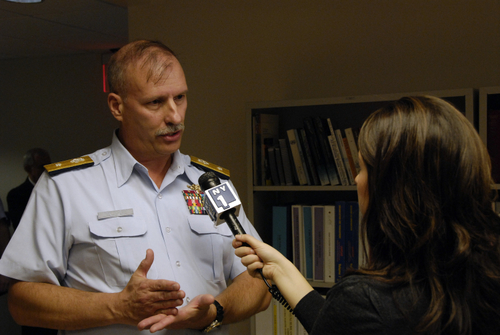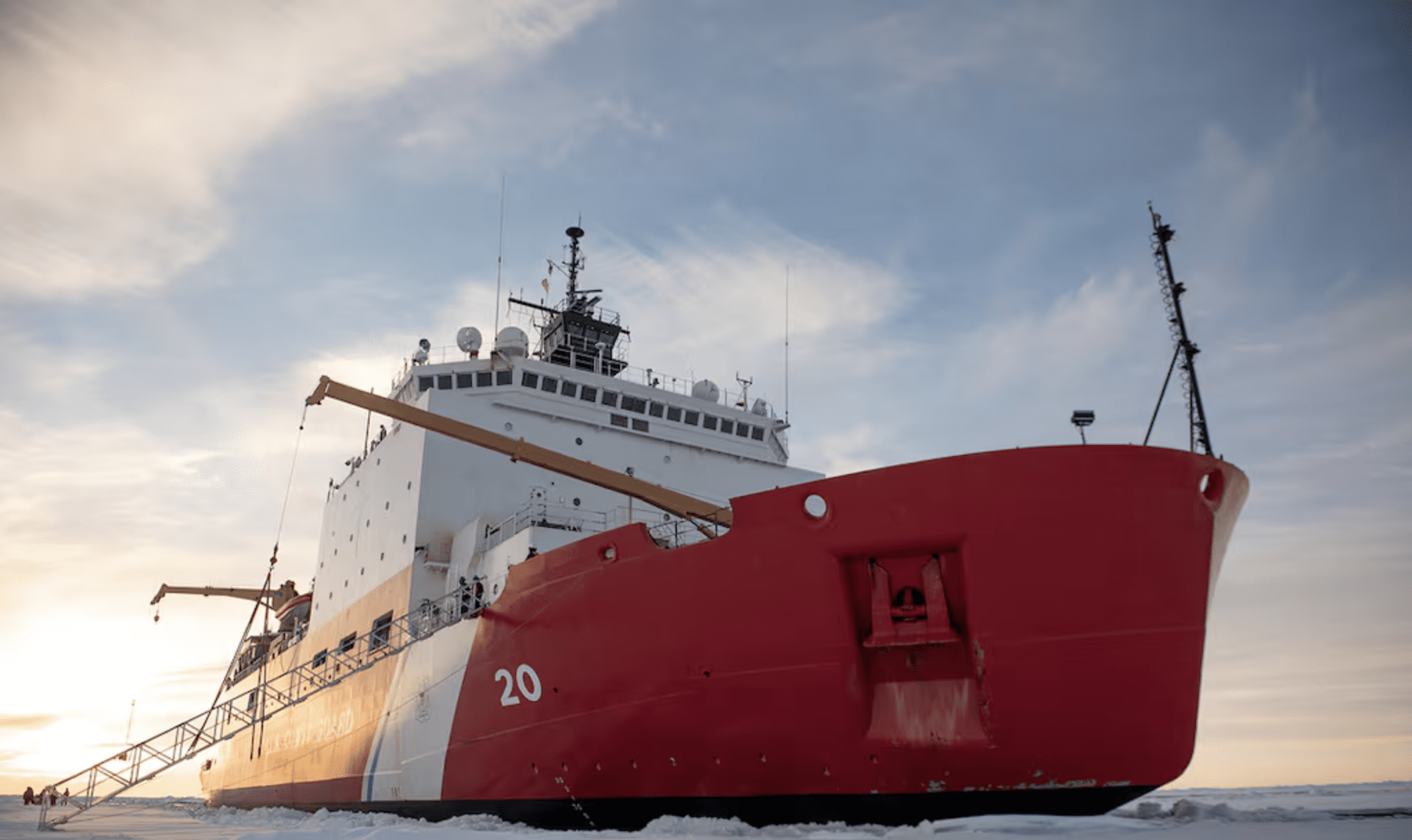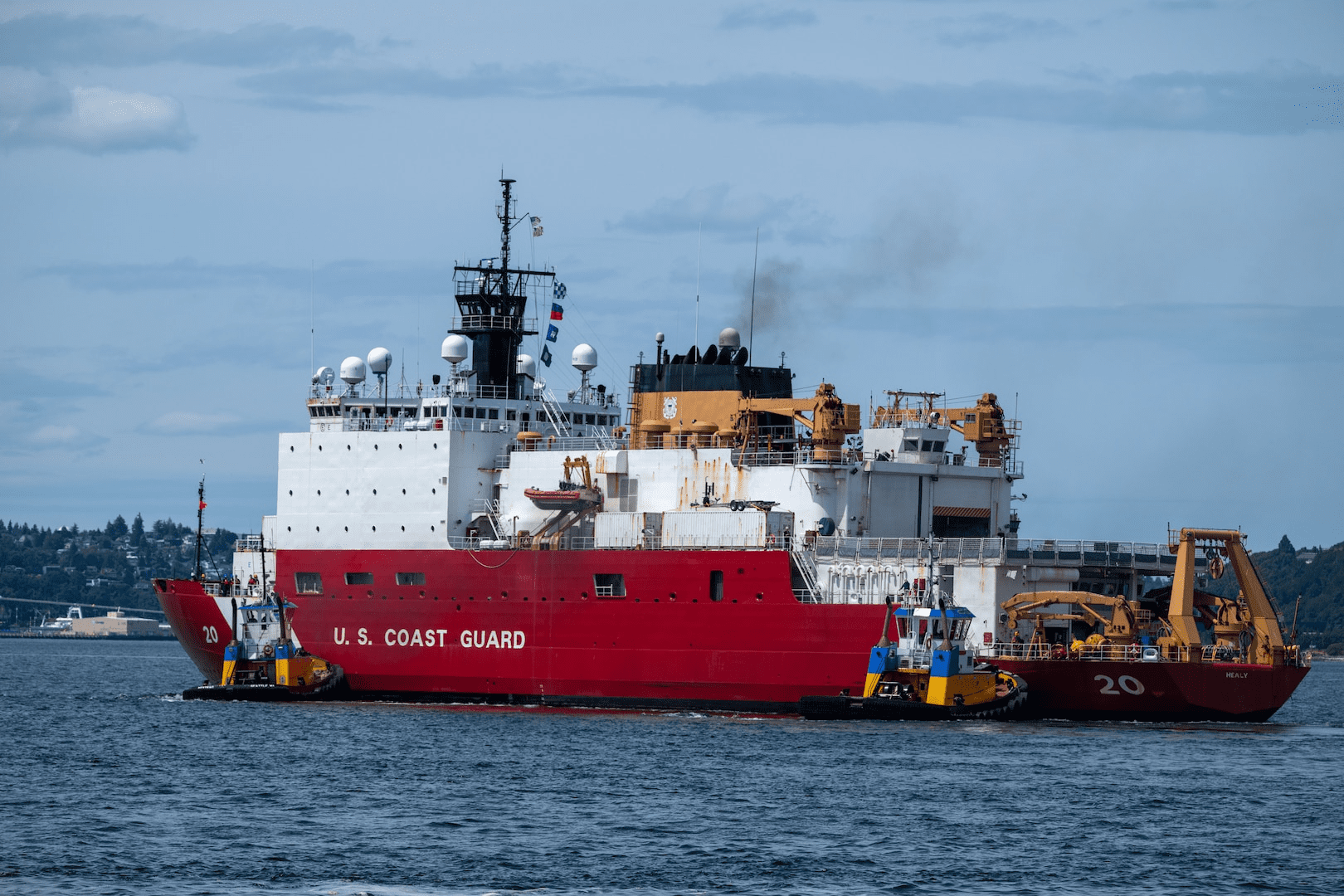
On June 12, 2009 Rear Admiral Ronald J. Rábago assumed duties as the new Assistant Commandant for Acquisitions and Chief Acquisition Officer of the United States Coast Guard. Previously, Rear Admiral Ronald J. Rábago served as the Coast Guard Program Executive Officer (PEO) on a two year assigment. His duties as PEO included management oversight of all Coast Guard acquisition programs and projects, including Deepwater, which provides for the sustainable, modernization, and recapitalization of surface, air, command and control, and logistics assets for the Coast Guard’s multiple maritime missions. A press release issued today from the USCG states of his new duties:
The Coast Guard’s newest two-star admiral is Rear Adm. Ronald J. Rábago, a 1978 graduate of the Coast Guard Academy. Rábago previously served as the Coast Guard Program Executive Officer and Director of Acquisition Programs since the establishment of the Acquisition Directorate July 13, 2007. Rábago’s new duties include direction of all Coast Guard acquisition programs and related procurement management, contracting and research and development activities to support the service’s $27 billion acquisition investment portfolio. That portfolio consists of 22 major acquisition projects which deliver the systems, products and services necessary for mission execution. Read Full Release
While serving his previous assignment as PEO, gCaptain was lucky enough to speak with Rear Admiral Ronald J. Rábago about the Aquisitions program and its Rescue 21 system. The interview is previded below. Rear Admiral Ronald J. Rábago Bio
Full Release from USCG
—
INTERVIEW:
gCaptain: First, can you give me a brief idea of what Acquisitions does and how it affects the professional mariner?
Sure, good place to start. As you know the Coast Guard, which is 40,000+ strong, has many responsibilities. Obviously we have regulatory responsibilities, in the sense of the merchant marine, but we also have law enforcement, national defense, and environmental responsibilities. In terms of the maritime industry, we interface on a one-on-one basis in a number of areas. The Coast Guard works directly with mariners on board ships, in the harbors and ports, out at sea, and a variety of different forums. In order to do that, we need the equipment, communications systems, and all the hardware that enables our people to go out and do the missions. That is where Acquisitions comes in.
The Coast Guard’s missions seem to grow with every new year. The good news is that new technology permits our people to be more effective in their day-to-day work. That could be at a command center where we have people directing resources and assets, like a search and rescue case, reaching out to a merchant mariner, or in response to an oil spill. It could even be one of our aircraft on a routine patrol or in support of surface assets that are executing a mission.
Now, especially with our ships but really across the board, our systems are old. We have some cutters that are past the time where they need to be replaced. There comes a point when a ship is more expensive to maintain than it is to replace. We are at that point with a number of platforms and are in the process of upgrading and replacing them. This is also true with the aviation piece. They get to a point where if you have a certain number of operating hours on an airframe, you must replace it. Our aviation acquisition program is currently modernizing and upgrading some of our assets.
One of the first things that Admiral Allen directed as he came in as Commandant, among other things of course, was to make sure that our Acquisitions Directorate was unified and operating effectively with our technical authorities and the sponsors, who set the requirements to recapitalize our fleet as expeditiously and most effectively as possible.
We are now in the process of recapitalizing many of our systems. Specifically, the ones we are focusing on here in the Acquisitions Directorate, and it’s pretty much inclusive, is all of our ships, our boats, our communication and data systems, and our aircraft. All of which need to be multi-mission platforms and systems in order to do the full range of Coast Guard missions. Importantly, just as we are stewards of public policy, we are also stewards of taxpayers’ dollars. Making sure that we execute the recapitalization and replacement of our systems and bringing things up to date with new technology, are things we need to do in a way that demonstrates good stewardship of the taxpayers’ dollars. That is one of the key directives in the way we do business.
gCaptain: Can you clarify the role of sponsors?
Sponsors are the link to the operational commander. A Sponsor’s role is to set requirements. In other words they’ll say, “I need an aircraft that is able to fly X distance and can perform Y missions”. These requirements then get turned into contracts which are given to us here at Acquisitions and then we go acquire the systems, equipment and capabilities to meet those operational requirements.
gCaptain: Interesting. I can understand the physical assets: ships need to be replaced and new technology needs to be incorporated, but the data systems are less apparent to the average mariner. How much of your overall budget and efforts go into these new data systems?
Great question. That is really the place where technology has moved the quickest and we are trying to capitalize on that technology. Probably the biggest piece of that is the ability for data to flow across networks. Of course networks like the Internet, communication webs and satellite communications are much more prevalent today than they were 50 years ago and we are leveraging all of those technologies to pass information on to our assets.
I’ll give you a couple of good examples that we are working on here in the Acquisitions Directorate. You are probably familiar with AIS (Automatic Identification System). That system allows information about a ship (position, course, speed, etc.) to be transmitted to other ships in the area and of course to the shore. So using network technologies, we can be aware of what ships are coming and going into our ports. Of course that is important for the mariner and important for national security so we can see the large ships that come in and out of our harbors.
gCaptain: Is AIS going to remain VHF based?
Well I think you will continue to have voice radio as the means of communication, but as you may know, AIS currently has a messaging capability that sends the Coast Guard a ‘receive only’ message. We are in the process of awarding a contract that will allow us to transmit data messages as well. We hopefully will be able to transmit out a variety of messages like a ‘notice to mariners’, security issues for a particular port and those kinds of things. However, there is a limited size on these AIS messages, so voice radios (using VHF) will still be a key communication tool. So AIS allows the Coast Guard Sectors and other port partners to maintain awareness.
AIS is also a way of putting a name on top of a radar contact. Technology now allows us to fuse information that we are receiving. One of the key future goals is to merge all of this data together and in fact, we have another Acquisitions project that is going to give us an inter-agency operations center, which will enhance our existing command and operational centers and will fuse information. We are also looking to merge in our Rescue 21 capability. Are you familiar with that?
gCaptain: It’s a little confusing to be honest. Can you please explain?
Sure. Rescue 21 is a VHF radio based system made up of a series of antennas strategically placed to provide full coverage along the coastline. Right now we have over 20,000 mi. of the US coastline protected by the system.
Before Rescue 21, if you had a distress or an emergency situation, you would get on your VHF radio and issue a communication hoping someone would hear you. If someone were shore based, the Coast Guard or a good Samaritan heard you, they would pass the information on and that would precipitate a response. But as you can imagine, in an emergency situation where you only have time to get off a brief message, your mayday might not have been heard correctly or exactly.
Rescue 21 allows you to capture, in a digital format, any VHF call. It also has direction finding capability. It provides a line of bearing directly to where the call is and if you have more than one antenna, you get a cross-hair to pinpoint the exact location. Even with a single line of bearing we can come right across the distressed mariner, without having to execute a search plan.
It even uses digital selective calling. Almost all new VHF radios have this. For example, if you hit the distress button, and it is hooked up to your GPS, it communicates very specific information and Rescue 21 picks it up without any voice needed at all. It also has the ability to capture everything digitally for replay and disaster recovery capability so we can redirect the control of antennas, using satellite technology, to communicate to a different location. It’s a very robust system.
gCaptain: So it’s really correlating and subsequently using the information that comes in from the ship?
Absolutely. 20 miles is what we set as our standard but we are regularly picking up and correlating transmissions much further out, so that proves the accuracy of the system. We have found that because of the requirements we have set for it that if you are in typical VHF radio of 25 watts or more, those transmissions are heard a great deal further.
The other thing it does, and we’ve come to find this out through deployment, is it allows us to get rid of hoax calls. In the past, as you can imagine when the weather was rough and you got a mayday and couldn’t correlate exactly where it came from, you would have to send someone to go check out the situation. But now, we can often determine if it’s a hoax call when you see the signal coming from inside a harbor or a house or something like that. That of course keeps our people needlessly out of harm’s way and saves the tax payers money.
So, it’s a great technology that allows us to be much more effective in terms of the value and effectiveness of our people in command centers. They can process a lot more information and communicate with more Coast Guard assets.
gCaptain: Being able to push messages from the Coast Guard to the merchant fleet, and even back from the merchant fleet to the Coast Guard is a big improvement but it remains a linear communication system. Is there anything being done to promote communication amongst ship captains in the same way businesses communicate with each other today?
That is a great question; unfortunately I cannot speak accurately to. I am going to pass that on to our Marine Safety Office who is looking at ways to communicate more effectively with the shipping industry at large, at all levels from captains to ship owners. I think they might be able to answer that more accurately.
gCaptain: What is the process for periodically reviewing new technology and do you ever look at old technology to determine its sustainability?
We do have a process for reviewing new technologies. We work with a variety of different industry partners to look at capabilities we currently have. Our technology is really right in line with the things that are coming out, that are available and applicable to Coast Guard missions.
We definitely try new things out also. We prototype new technology and we are always looking for things that enhance our ability to do our missions. Also, we are good stewards of the tax payers’ money. We don’t do a lot of things that are too far out there. But of course we want to deploy technologies that will work, that will benefit our missions, and our nation.
gCaptain: What assets are coming forth that really improve mariners’ safety?
Well Rescue 21 is probably the pre-eminent asset around our coast and our plan is of course to deploy it along all of the US coast line including Alaska and Hawaii, along the Great Lakes and even, although limited, along some inland rivers. That will help us a great deal and, quite frankly, allow us to hear the calls within our coastal boundaries.
We are also looking at some new technologies, with AIS in particular, that allow us to use satellite technology to give us better knowledge of where ships are.
Of course you know, AMVER is a great system that has been working for many years and is critical to the safety of mariners. It has had a direct result in saving lives and property over the decades. It is a kind of a simple concept but it has done great things for the mariner.
Again with the use of Rescue 21, we have discovered many new things that it can be used for. One of the things we recently discovered was using the new EPIRB frequencies. That communicates up to a satellite and we have now equipped aircraft with sensors that can pick up a homing signal put out by this new EPIRB. That has allowed some of our aircraft to home in directly to a mariner in distress even if we didn’t have a VHF call but knew someone was in distress from the satellite alert.
gCaptain: Homing in on the 406 EPIRB frequency, that’s certainly interesting.
Yes, that’s the new standard. I think they just closed out the old 121.5MHZ Class B standard and have gone to the newer standard of 406 MHZ that can be received by satellites. So we are equipping all of our aircraft with the ability to home in on the new 406 MHZ EPIRB to take advantage of the new standard.
So, Rescue 21 with lines of position, AIS technology, improved satellite usage and capability, and then using EPIRBS and the technology that is there, all speak well to addressing the safety of the mariner which obviously is a mission that the Coast Guard has had since its inception and one that we take very seriously.
Shortly after the interview the Coast Guard announced the award of a contract to Northrop Grumman Space & Mission Systems Corp. to deliver the core Nationwide Automatic Identification System data exchange capability.
Under the contract, valued at about $12 million, Northrop Grumman will provide the necessary shore-side communications, network and processing capability to ensure the effective exchange of Automatic Identification System information between AIS-equipped vessels, aircraft, aids to navigation and shore stations within all major U.S. ports, waterways and coastal zones as well as from AIS-equipped vessels bound for the U.S.
You can read more about the NAIS contract HERE.
Of note, the office of marine safety contacted us shortly after the interview and has begun exploring the idea of a collaborative system for communication in the nation’s ports.

 Join The Club
Join The Club











